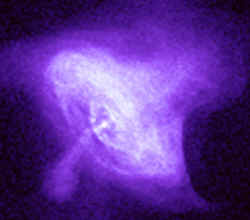Neutron Star’s Glitch is Physicists’ Gain

Squeeze a mass larger than the Sun into a sphere 20 km across and you have a neutron star. That huge density–higher even than that of an atomic nucleus–leads to a bizarre state of matter that physicists would like to understand. For many neutron stars, one of the few properties astronomers can directly measure is the rapid and steady spin rate. Occasionally, the spin rate will suddenly increase without warning after years of predictable behavior. In the 25 October PRL a team shows that these “glitch” events are not completely random and that, with only a few basic assumptions, analyzing them leads to new information about neutron star properties and possibly some tests for neutron star theories.
Astrophysicists have pieced together some detailed theories of the exotic physics of neutron stars, but they’re hard to test. Each theory predicts a different relationship between the mass and the size of a neutron star, so any other measurements of those properties could help rule out incorrect theories.
Bennett Link of Montana State University in Bozeman and his colleagues investigated the glitches observed in seven neutron stars, looking for such constraints. With 30 years of observations on the Vela neutron star, they found that “the glitches are not random events at all,” says Link. The team’s statistical tests showed that Vela’s record of a glitch about every three years is very unlikely to have occurred by chance.
The standard explanation for glitches is that some component of the star spins faster than the outer crust, but during glitches–which may last from minutes to days–there is some temporary “traction,” during which angular momentum is transferred from the faster component to the crust. Without assuming any detailed theory for glitches, Link and his colleagues used the long record from Vela to derive a minimum size for the component that “slips” with respect to the crust: The “loose piece” must comprise at least 1.4% of the star’s total rotational inertia (the mass- and shape-based measure of its response to an applied twist).
That result is consistent with a popular notion that the freely spinning component is a superfluid–a liquid experiencing no friction or viscosity–flowing through a rigid matrix in the thin crust of the star. As the solid portion is slowed by electromagnetic forces, the liquid continues to rotate at a constant speed, just as superfluid helium continues to spin long after its container has stopped. Assuming that the loose piece is the liquid that coexists with the crust, the team could almost immediately calculate the minimum size of this star: If it has a typical neutron star mass of 1.4 times that of the sun, the authors say it must be more than 18 km in diameter.
That constraint does not automatically rule out any current theories of neutron star structure, but it adds a new type of limit for assessing the theories, once some reliable size and mass measurements come in. “What we need is a data point,” says Link, and he adds that planned observations of a nearby neutron star using the Hubble Space Telescope and the Chandra x-ray telescope may soon provide those hard data. Ira Wasserman of Cornell University says many other attempts to extract information from glitches have relied upon detailed theories which remain untested. He is impressed that Link and his colleagues used only a few solid assumptions about the crust–the best understood region–to get information about the mass and size of a neutron star.


